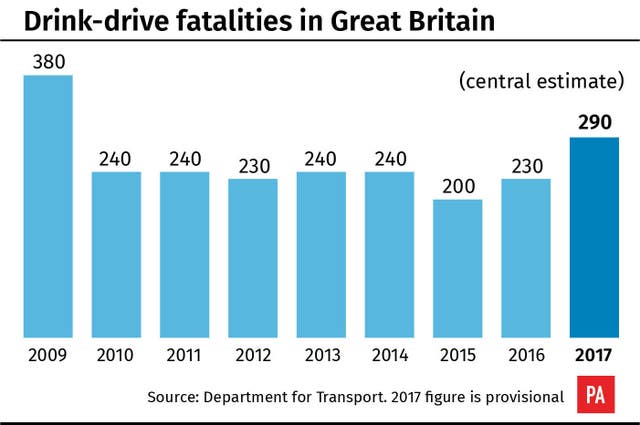
The number of drink-drive fatalities has reached its highest level since 2009, according to provisional estimates.
Between 240 and 330 people were killed in crashes on Britain’s roads in 2017 where at least one driver was over the drink-drive limit, Department for Transport (DfT) figures show.
This represents about 16% of all road deaths.

The “central estimate” fatality figure of 290 is up from 230 during the previous year and is the most since 2009.
The DfT said the year-on-year increase is “not statistically significant”.
An estimated 8,660 people were killed or injured in drink-drive crashes, down 4% on the previous year.
RAC road safety spokesman Pete Williams said: “This is a serious cause for alarm and reflects a worrying change in attitude by a number of drivers who are prepared to risk their own life and that of others by drinking and driving.
“Anyone who has lost a loved-one in a drink-driving accident will testify to how devastating and needless this is.”
He added: “With the reduced number of roads policing officers, it appears more drivers are thinking they can get away with drinking and driving.”
Final drink-drive casualty figures for 2017 will be published in August.
The Scottish Government reduced the alcohol limit for drivers from 80 milligrammes (mg) per 100 millilitres of blood to 50mg in December 2014, but the legal level in the rest of the UK remains among the highest in Europe at 80mg.
Josh Harris, director of campaigns at road safety charity Brake, said: “Our current drink-drive limit gives a false impression that it is acceptable to mix alcohol and driving, which couldn’t be further from the truth.
“Even very small amounts of alcohol dramatically affect your ability to drive safely.
“Decisive action is needed to end this blight on our roads and prevent the needless loss of life.
“Brake is calling for the Government to implement an effective zero-tolerance drink-drive limit, making clear to drivers that not a drop of alcohol is safe.”
A DfT spokesman said: “Drink-driving is absolutely deplorable, and those who do it not only put their own lives at risk but other people’s too.
“The Government is working with industry to develop new roadside breath tests, meaning drink-drivers do not have the chance to sober up before being tested, while the THINK! Mates Matter campaign had the biggest impact in young drivers’ attitudes to drink-driving in a decade.
“We are also looking at how to make our roads safer as part of our upcoming road safety action plan.”

Enjoy the convenience of having The Sunday Post delivered as a digital ePaper straight to your smartphone, tablet or computer.
Subscribe for only £5.49 a month and enjoy all the benefits of the printed paper as a digital replica.
Subscribe